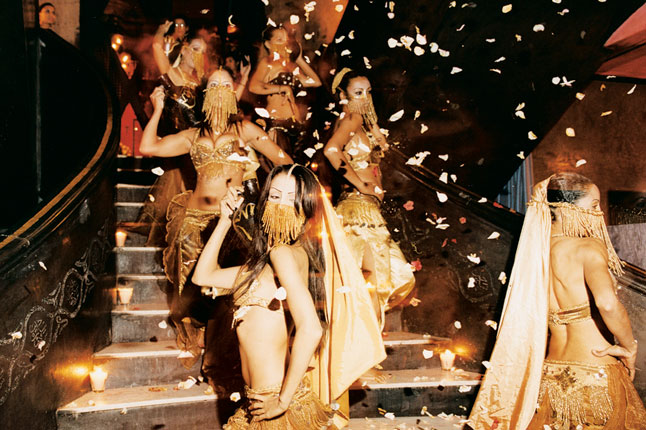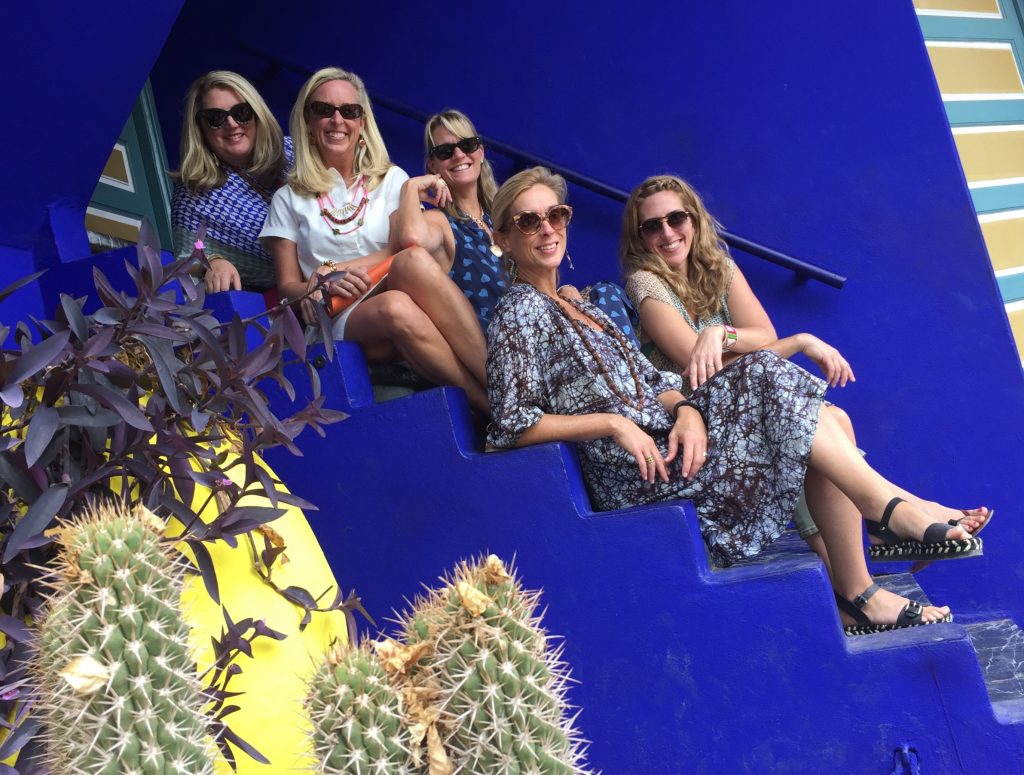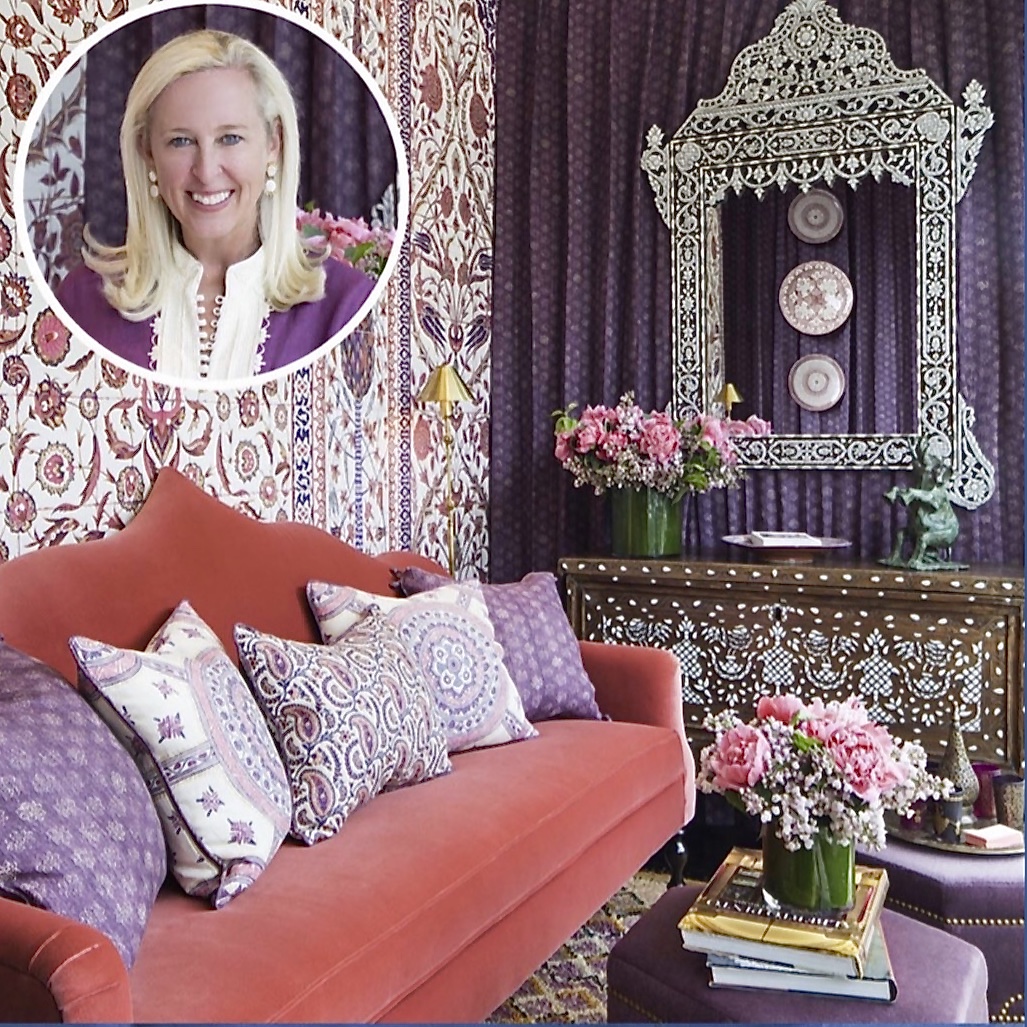“Once upon a time, five designers embarked on a creative pilgrimage to Morocco. In addition to liberating their imaginations, they discovered the magic of Marrakech through the lens of the lovely locals that acted as their guides to translate the mystery of the “Rose City.” Along the way, they encountered monkeys, camels, serpents, belly dancers, magicians, artists, musicians, gypsies and had the design adventure of a lifetime.” -Our Moroccan FairyTale

Julia Buckingham, Holly Phillips, Krista Nye Nicolas, Mustapha, Tami Ramsay and Moi // The Koutoubia Mosque
Known as the jewel of Morocco, Marrakech has been the epicenter of culture and trade for over one thousand years. The pink walls, meandering alleys, and doors leading to palaces, courtyards and magnificent riads, are a feast for the eyes. The convergence of the most exotic cultures in the world, European, Arabian and African, is revealed in everything from the art and architecture to the cuisine and culture. The entire city shifts in color from pale pink in the morning light to a deep rose in the late afternoon sun. We could not have picked a more ideal destination to leave behind the hustle of everyday life and escape into this bohemian fantasy world.
To seek out the best interiors and design elements, we made sure to see every iconic hotel, restaurant, and rooftop that Marrakech had to offer. We planned our itinerary to have days of intense sightseeing and shopping offset with days with a (very slightly) more relaxed pace. Our grand finale took us to La Mamounia where we only left the grounds once to see the famed Jemma El Fna on our last night.
DINE



EL FENN is the perfect retreat from which to enjoy Africa’s most exotic city. Combining grandeur and historic architecture with hideaway nooks, terraces and gardens, the hotel is just five minutes from the world-famous Jemaa El Fna square and bustling maze of streets that make up the souk.In 2002 Vanessa Branson and Howell James were looking for a holiday home and walked into the almost ruined courtyard of one of Marrakech’s formerly great private homes. Nearing dusk and with the sound of the muezzin’s call to prayer echoing in the air, they instantly fell in love with the atmospheric house. They soon realized that their holiday home was going to become so much more. On the rooftop, you can enjoy a breakfast of breads, pastries, fruit and eggs complete with sunshine and a view of the Atlas Mountains. By noon, the day’s set Moroccan lunch menu changes according to what’s in season or you can pick a dish from our light menu that runs until 6pm. On warmer evenings, dinner is served under the stars.


LE JARDIN is located through a small door opening to a large courtyard enclosed in a 17th-century mansion. Interior designer Anne Favier reinvented this very beautiful house in the Sidi Abdelaziz quarter. They found it in ruin, and renovated it in tones of green, adding lots of plants, trees and water features, into a small oasis…A cool 1960s décor imagined in harmony with all the Moroccan crafts, creates a very contemporary feel.

MAISON MK is a foodie focused spa hotel…and full of personality. A retired fashion photographer transformed a 600-year-old riad in the Marrakech medina into Maison mk hotel, a design den that blends traditional Moroccan motifs with modern minimalist touches. The teardrop-shaped plunge pool, vibrantly coloured fabrics and silk artwork all showcase an eye for detail at this comfortable contemporary retreat.




DAR YACOUT Every visitor to Marrakech has to try Dar Yacout, a medina institution. Follow winding alleyways to the restaurants courtyard, strewn with petals. Designed in the early 1990’s by American expat architect Bill Willis, this fantasy palace—shiny tadelakt (polished plaster) walls, scalloped columns, and striped turrets—has influenced Moroccan interiors ever since. A landmark of Marrakech, it was amongst the first created twenty years ago in the medina by Mohamed Zkhiri, who presides over the destiny of this sumptuous venue. The decor is enchanting with its private rooms and breath-taking panoramic view from the terrace overlooking the medina and the Koutoubia mosque of Marrakesh. Highly traditional Moroccan gastronomic cuisine with a menu incorporating an amazing succession of flavours, and service that lives up to anyone’s standards.



BELDI COUNTRY CLUB Like many Marrakech residents, Jean Dominique Leymarie makes his home in the medina. But he was intrigued by the idea of creating a retreat from the dust and noise, so he bought some land just outside town, planted 15,000 rosebushes, put in a pool and a spa, and invited the public to spend a day in the country. It proved a hit, and in 2009 he added a luxury boutique hotel to the mix. Designed in the traditional – or beldi – style that is the heart and soul of Morocco, the 28 rooms were built of earth, plaster, wood and iron, and furnished entirely from local markets. They form part of a living, breathing Moroccan village with craft workshops, a bakery and souks selling Safi pottery, hand-embroidered linens and Berber carpets. All around are 15 hectares of magnificent grounds, filled with palms, olive and fruit trees, tall grasses, herbs and a sea of roses. It’s a 10-minute hop by taxi to the medina, and staff can arrange lakeside picnics at their kasbah in the Atlas Mountains, whose snow-capped peaks shimmer in the distance. Return each evening to find dozens of lanterns glowing along serpentine paths to the 3 restaurants, bar and cosy salons, creating a sublimely magical and private setting.


LE COMPTOIR is a legend in Marrakech, but not necessarily for the food. The Franco-Moroccan dishes are served with some panache and rarely fail, but the atmosphere and the spectacle are much more memorable. It’s a mix of restaurant, lounge and boutique, in a large Art Deco villa. Head straight to the upstairs bar for a pre-dinner drink and you’ll understand what the fuss is about and why this place has a reputation. Downstairs, the large, plush-red dining room is more stageset than restaurant. The menu is a mix of French, Moroccan and Asian influences. Minds tend to wander from the food to the floor around 9.30pm, when lithe belly dancers descend the big staircase to cavort around – and, if you are lucky, on – the tables. The place carries on buzzing, upstairs and down, till late in the night.

BO ZIN This hip restaurant and lounge is set in an exotic garden where luxurious fountains and summer lounges were designed for your well-being, an invitation to dream, a mixture of Zen spirit and elegance. Live music and performances add to the unique experience.


LING LING /MANDARIN ORIENTAL Ling Ling draws inspiration from the izakaya concept made popular in the East, where food accompanies the drinks and not the other way around. With drinking, dining and dancing at the forefront, Ling Ling bends the Hakkasan DNA to create a restaurant and bar experience that reflects and complements the environment. Created by Executive Head Chef Tong Chee Hwee, the menu features reinvented presentations of the Cantonese cuisine synonymous with Hakkasan, perfect for sharing between friends. The cocktails are at the heart of the experience, with an intriguing drinks and wine list curated by the award-winning team in London. Designed by Parisian duo Gilles & Bossier and located in the West wing of the lobby, Ling Ling has a spacious outdoor terrace overlooking the gardens, lounge and bar.
SEE

KOUTOUBIA MOSQUE Five times a day, the muezzin calling the faithful to prayer from atop the Koutoubia Mosque minaret. Excavations confirm a longstanding Marrakshi legend: the original mosque built by Almoravid architects wasn’t properly aligned with Mecca, so the pious Almohads levelled it to build a realigned one. When the present mosque was finished in the 12th century, 100 booksellers were clustered around its base – hence the name, from kutubiyyin, or booksellers.



MEDERSA BEN YOUSSEF “You who enter my door, may your highest hopes be exceeded” reads the inscription over the entryway to the Ali ben Youssef Medersa, and after almost six centuries, the blessing still works its charms on visitors. Founded in the 14th century under the Merenids, this Quranic learning centre was once the largest in North Africa, and remains among the most splendid. Sight lines are lifted in the entry with carved Atlas cedar cupolas and wooden-lattice screen balconies. The medersa’s courtyard is a mind-boggling profusion of Hispano-Moresque ornament: five-colour zellij (mosaic) walls; stucco archways; cedar windows with weather-worn carved vines; and a curved mihrab (eastern-facing niche) of prized, milky-white Italian Carrara marble.





LE JARDIN MARJORELLE These famous gardens were started by the painter Jacques Marjorelle in 1937, opened to the public in 1947, and eventually purchased by Yves St. Laurent and Pierre Berge in 1980. Click here to read about these legendary gardens.


JEMAA EL FNA The medina’s central square means “Assembly of the Dead” since the plaza was the site of public executions around AD 1050. The daily performances include snake charmers, henna tattoo artists, acrobats, musicians, tooth pullers, herbalists and fortune tellers. At dusk, it becomes the country’s largest street fair with over 100 chefs arrive with grills in tow to set up their food stalls. UNESCO declared the square a ‘Masterpiece of World Heritage’ in 2001.
Stay tuned for PART 2 featuring where to SHOP, STAY and SPA in Marrakech coming soon!
Please follow along for more design adventures on Instagram, Pinterest, Facebook, Twitter, and subscribe to Bespoke Banter. Thanks for reading!













